Excerpts from the website of HIM great
grand-daughter Princess Esther:
It was the night, not the morning... The eucalyptus
leaves would tremble... Silver and silk, flesh of vegetation... The black
dove flew from Harar to the Menelik palace in the capital, dark as night
to confirm the news. Ras Makonnen with his army was one day away from
Harar when they woke him up this night. It was a boy.... |
A century ago it was another Africa in a different
world we hardly remember. There was no Addis Ababa but the fourth
sacred place of Islam, ancient Harar, where the future Christian
ruler of Ethiopian empire was born. Baby Tafari Makonnen was born
on July 23, 1892, according to the western calendar; in the year
of St. John.... A boy was born, not a prince....
The first tragedy happened before he could understand
it - death of mother. He didn't remember her. Tafari grew up without
mother. He was his father's son, in spirit and tradition. Ras Michael
had big plans for his boy. He was his heir, his pride and his hope.
Tafari began to govern at age of twelve. Father died when he was
twelve.
The father's side of the family was known and
powerful. Ras Makonnen Welde Mikael was the cousin and right hand
of Mighty Menelik II, (pic right) King from 1855 and Emperor
since 1889. The family was from the core of the royal web of the
Amhara dynasty which ruled Abyssinia for the last seven centuries....
His great grandfather was King Sahle Sellassie of Shoa (Solomonic
dynasty, 1813-1847).... Wezero Ehte Mariam, Tafari Makonnen's cousin
from his father's side, had married Haile Sellassie Abayneh and
given birth to Imru (who later became Ras Imru), when Tafari was
four months old.....
|
|
|
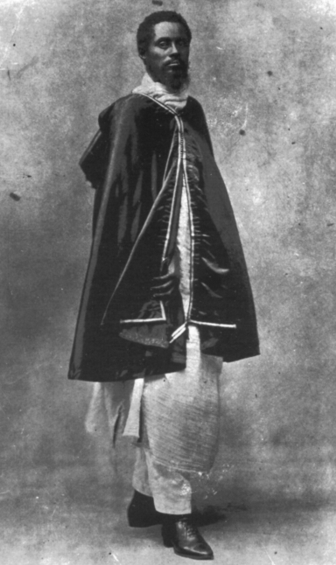 |
.... The appointment of Tafari
as a governor of Harar was designed by his father, who was Ras
of the whole region of Harrarge, but as usual it had to sanctioned
by the Emperor. As it was customary, the title of "Dejazmatch"
was also conferred upon him. Becoming Dejazmatch (also a count
or, literally, commander of the gate) at such early age happened
because Ras Makonnen neared death and he had to entrust Tafari
to his long time friend - the Emperor. Menelik liked the boy.
He saw the great future in Tafari and treated him as his own son....
He loved his father. Ras Makonnen
(pic left) was one of the best man of his time, he wanted
his son to be a learned man, ready for new times. Tafari was his
son among two dozens of bastards the Ras left behind, following
a traditional manhood life. Tafari wasn't a boy, he was a prince.
By the age of ten Tafari and Imru
could read and write in Amharic and Ge'ez, an ancient Ethiopian
language and the language of the church. Of course, they had to
learn the art of warrior - horse riding and shooting. The boys
had to observe the business of governing, to be present at all
the ceremonies, receptions, trails.The two were brought up unlike
the sons of the princes of the ancient time. From Teodoros and
Menelik the physical labor taboo for Abyssinian nobility was broken.
The boys had to learn how to serve in order to know how to rule.
Menelik himself put the first stone at the foundation of the St.
Trinity church in his new capital. Work was a virtue of new leaders
of Ethiopia.
Tafari knew that he had
to serve his God and his country.
|
|
Ejarso Goro, land of majestic nativity
To the north of Harar is a terrible road that leads to the attractive
and interesting birthplace of Haile Selassie. Given the subsequent illustriousness
of the prominent son of Ejarso Goro village, the place itself
remains very humble. I couldn't help but be struck by the neglect
of the mud walled community by their Emperor.
The only exception is the church, which is quite large and elaborate
but also very neglected. It was moved to this site by Haile Selassie
in 1953 Ethiopian calendar (about 1960 European calendar) to put the place
of his birth on holy ground. The head priest, Mamhere Mengiste
Tagene, showed us the site. The church is fairly large and disconcertingly
orange. There is a place on the front where the plaque commemorating the
birth of Haile Selassie was unceremoniously ripped off by agents of the
Dergue government.
|
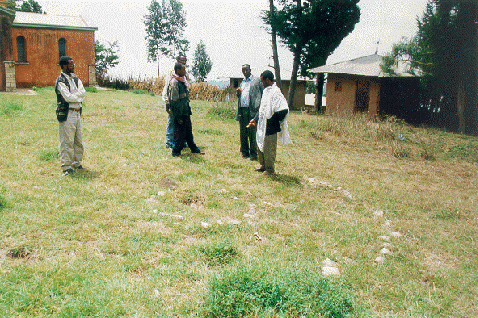 The birth place
of HIM in Ejarsa Goro, Harar The birth place
of HIM in Ejarsa Goro, Harar |
Although the grounds are neglected and overgrown,
the priests can show you the main points. A circle of rocks marks the
place where Haile Selassie's father, Ras Makonnen, built his country house.
He picked a nice spot. The hills rise steeply from Harare, which is already
at a respectable altitude. One can see how Makonnen, as a Shoan highlander,
would want to find the highest and coolest place available to escape his
town house in Harare.
The other specialty of the grounds is a small tree stump
which takes some effort to separate from the undergrowth. This,
we are told, is a tree planted the day Haile Selassie was born, and which
died the day he [ascended]. |
The church does not suffer from an excess of foreign visitors. In the
previous year they had three. The year before that was big, they had five.
Most of them were Jamaicans, presumably Rastafarians keen on the birthplace
of the revered Haile Selassie. The small local Christian congregation
of about 150 lacks the resources to maintain the church. The mosque across
town is well tended by comparison. The Mamhere told us that a fund raising
committee had been set up to sponsor repairs. We weren't able to see the
inside of the church to assess the need ourselves. As sometimes
happens in Ethiopia, the elusive fellow with the key was not to be found.
|
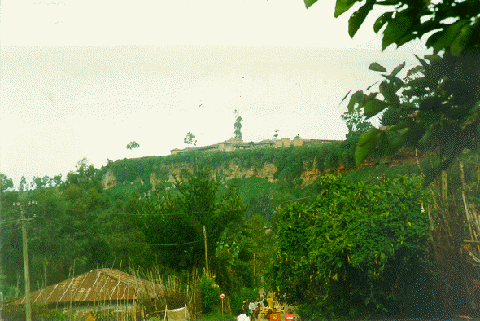 Lij Yasu's prison on the hill above Girawa, Harar
Lij Yasu's prison on the hill above Girawa, Harar
|
South of Harar is a large expanse of lush highlands.... The ridge rises
rapidly, and on the day I was there disappeared fetchingly into clouds
at the top. The sides were forested and graced with impressive rock
formations. Horses wandered across the road from one patch of trees
to another. It was nice.
Of historical interest is the jailhouse that was the final
resting place for the deposed Emperor Iyassu at Girawa. This
can be found 10 kilometers down the road that branches off just as you
reach the spectacular corner at Garamuleta.
- from forthcoming book "Ethiopia: Off The Beaten Trail"
by John Graham
|
Birth of a new Ethiopia
HIM renamed His ancestors' empire from Abyssinia to Ethiopia, an act
of Istoric significance giving birth to "modern ethiopianism",
now known as Pan-Africanism. The word Ethiopia, meaning land of sun burnt
faces, is the oldest known word to refer to all the black peoples of the
world as one group. The birth of new Ethiopia coincides with Jan Hoi's
campaign described as "life and death struggle with the white race,
the consequences of which are incalculable. The targets are the colonial
powers in Africa without exception.... characteristic of the mentality
and attitude of the natives [Ethiopians] who imagine themselves to be
infinitely superior to the white race.... The final aim of [Ethiopian]
policy of antagonism to the white race... is nothing less than to act
as the champions of all the colored peoples of Africa." ("Abyssinia,
The Powder Barrell", Baron Roman Prochazka, 1935)
|
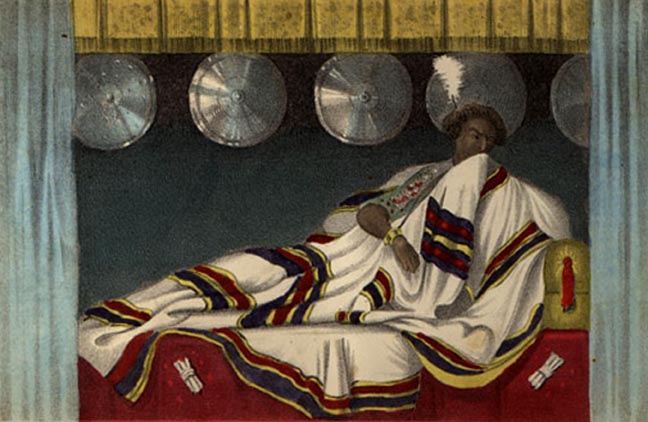
Sahela Selassie, Negus of Shoa (1813-1847), the visionary Solomonic king |
Following are some historical notes which indicate the roots in antiquity
of Jan Hoi's vision of Ethiopia: encompassing all bloodlines and clans
flowing from ancient Ethiopia, as it takes birth within the bloodline
of Emperors David and Solomon and the monarchy founded by Samuel the Nazarene;
the birth in ancient Ethiopia of the royal priestly order of governance,
known to us as the order of Malikizadek or Nyahbinghi; the Ethiopian birth
of the Egyptian order of Isis-Osiris from which is born the Coptic
order of St. Mark of the See of Alexandria, to which doctrinal position
the Ethiopian church has historically adhered, and was constitutionally
bound by Jan Hoi in 1955. |
"Where the south declines towards the setting sun lies the country
called Ethiopia, the last inhabited land in that direction. There gold
is obtained in great plenty, huge elephants abound, with wild trees of
all sorts, and ebony; and the men are taller, handsomer, and longer
lived than anywhere else. The Ethiopians were clothed in the
skins of leopards and lions, and had long bows made of the stem of the
palm-leaf, not less than four cubits in length. On these they laid short
arrows made of reed, and armed at the tip, not with iron, but with a piece
of stone, sharpened to a point, of the kind used in engraving seals. They
carried likewise spears, the head of which was the sharpened horn of an
antelope; and in addition they had knotted clubs. When they went into
battle they painted their bodies, half with chalk, and half with vermilion.
. ."
- Herodotus, The History, trans. George Rawlinson (New
York: Dutton & Co., 1862)
"The Dodonaeans called the women doves because they were foreigners,
and seemed to them to make a noise like birds. After a while the dove
spoke with a human voice, because the woman, whose foreign talk had previously
sounded to them like the chattering of a bird, acquired the power of speaking
what they could understand. For how can it be conceived possible that
a dove should really speak with the voice of a man? Lastly, by
calling the dove black the Dodonaeans indicated that the woman was an
Egyptian. And certainly the character of the oracles at Thebes and Dodona
is very similar. Besides this form of divination, the Greeks
learnt also divination by means of victims from the Egyptians."
- Herodotus: The Histories, c 430 BCE, Book 2, 57 |
"Ethiopia is older than pharaonic Egypt. We have some proofs
for this. People working on Ethiopia did not find the language of ancient
Egypt in Ethiopia. But in ancient Egyptian we found many words which are
in Ethiopia, both in Amharic and even more in Oromiffa. So, the conclusion
is that Ethiopia is the birthplace of ancient civilization which developed
later in Egypt and much later on in Greece and other countries.
Formerly I was an Egyptologist with knowledge of the hieroglyphics
system. But when I was in Ethiopia I found that there are the same names,
the same appellations for so many things that appeared at the beginning
of pharaonic language. For instance, there is a word "Oromo"
in Ethiopia which appeared in ancient Egypt referring to the same subject,
with consonants only, without using vowels. It would have been good for
a person who is an Egyptologist to study Amharic and Oromiffa and try
to list out words that were in use in both countries.
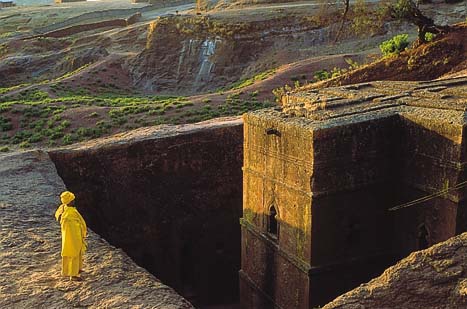 |
First we have proof that in Ethiopia there
was a very very ancient civilization. In Aksum, the fallen obelisk
is 37.5 meters high. It is extraordinary, it is taller than the
greatest Egyptian obelisks. And we do not know from where they took
this stone. It was not certainly from Aksum. They had to transport
this monolithic obelisk. This is a task as important as the building
of the Egyptian-pyramids. In Ethiopia we started studying archaeology
only fifty years ago. In Ethiopia there were stone carvings that
have helped the birth of ancient civilizations. This had developed
later in Lalibela and many other places. |
All of them [languages] are indigenous to Ethiopia. If you take the
South and the East, it is the cradle of mankind. To this, one can attest
the discovery of Lucy. It was an expansion of humanity, indeed. There
has been a belief that it started from Yemen. But it is the reverse. The
Sabeans in Yemen and Arabia were the extensions of the Sabeans in Ethiopia....[which]
was a large country having international significance. Historians understand
ancient Ethiopia as only having relations with countries on the Nile basin,
the Red Sea and the Mediterranean world. In fact my belief is that Ethiopia
had relations with the regions adjacent to the Indian Ocean, the remaining
of Africa and up to China.
During the Axum time we have inscriptions describing that Ethiopia's
territory was even wider than Ethiopia under Emperor Haile-Selassie and
Emperor Menilik II. The problem is some people understand Ethiopia only
in terms of Ethiopian Christianity limit. Muslim Ethiopia was highly related
to Christian Ethiopia. There was a good relation between the Christian
Ethiopia and Muslim Ethiopia which was in total called Ethiopia and was
under the same rule. The Jews, the Muslims and other non-believers believe
that they were Ethiopians. Then where is the limit of Ethiopia?"
- excerpts from Jean Doresse interview with Ato Akalu W.
Mariam;
Historian J. Doresse served HIM Ministry of Information (1960-62), described
it as "the happiest time of my life" |
"2.Now the Ethiopians, as historians relate,
were the first of all men and the proofs of this statement, they say,
are manifest. For that they did not come into their land as immigrants
from abroad but were natives of it and so justly bear the name
of "autochthones" is, they maintain, conceded by practically
all men; furthermore, that those who dwell beneath the noon-day sun were,
in all likelihood, the first to be generated by the earth, is clear to
all; since, inasmuch as it was the warmth of the sun which, at the generation
of the universe, dried up the earth when it was still wet and impregnated
it with life, it is reasonable to suppose that the region which was nearest
the sun was the first to bring forth living creatures. And they say that
they were the first to be taught to honour the gods and to hold sacrifices
and processions and festivals and the other rites by which men honour
the deity; and that in consequence their piety has been published abroad
among all men, and it is generally held that the sacrifices practised
among the Ethiopians are those which are the most pleasing to heaven.
As witness to this they call upon the poet who is perhaps the oldest and
certainly the most venerated among the Greeks; for in the Iliad he represents
both Zeus and the rest of the gods with him as absent on a visit to Ethiopia
to share in the sacrifices and the banquet which were given annually by
the Ethiopians for all the gods together:
 |
For Zeus had yesterday to Ocean's bounds
Set forth to feast with Ethiop's faultless men,
And he was followed there by all the gods.
And they state that, by reason of their piety towards
the deity, they manifestly enjoy the favour of the gods, inasmuch
as they have never experienced the rule of an invader from abroad;
for from all time they have enjoyed a state of freedom and of
peace one with another, and although many and powerful rulers
have made war upon them, not one of these has succeeded in his
undertaking. |
3.Cambyses, for instance, they say, who made war upon them with a great
force, both lost all his army and was himself exposed to the greatest
peril; Semiramis also, who through the magnitude of her undertakings and
achievements has become renowned, after advancing a short distance into
Ethiopia gave up her campaign against the whole nation; and Heracles and
Dionysus, although they visited all the inhabited earth, failed to subdue
the Ethiopians alone who dwell above Egypt, both because of the piety
of these men and because of the insurmountable difficulties involved in
the attempt.
They say also that the Egyptians are colonists sent out by the Ethiopians,
Osiris having been the leader of the colony. For, speaking generally,
what is now Egypt, they maintain, was not land but sea when in the beginning
the universe was being formed; afterwards, however, as the Nile during
the times of its inundation carried down the mud from Ethiopia, land was
gradually built up from the deposit. Also the statement that all the land
of the Egyptians is alluvial silt deposited by the river receives the
clearest proof, in their opinion, from what takes place at the outlets
of the Nile; for as each year new mud is continually gathered together
at the mouths of the river, the sea is observed being thrust back by the
deposited silt and the land receiving the increase. And the larger
part of the customs of the Egyptians are, they hold, Ethiopian, the colonists
still preserving their ancient manners. For instance, the belief that
their kings are gods, the very special attention which they pay
to their burials, and many other matters of a similar nature are Ethiopian
practices, while the shapes of their statues and the forms of their letters
are Ethiopian; for of the two kinds of writing which the Egyptians have,
that which is known as "popular" (demotic) is learned by everyone,
while that which is called "sacred" is understood only by the
priests of the Egyptians, who learn it from their fathers as one of the
things which are not divulged, but among the Ethiopians everyone uses
these forms of letters....
4.We must now speak about the Ethiopian writing which is called
hieroglyphic among the Egyptians, in order that we may omit nothing
in our discussion of their antiquities....
5.As for the customs of the Ethiopians, not a few of them are thought
to differ greatly from those of the rest of mankind, this being especially
true of those which concern the selection of their kings. The
priests, for instance, first choose out the noblest men from their own
number, and whichever one from this group the god may select, as he is
borne about in a procession in accordance with a certain practice of theirs,
him the multitude take for their king; and straightway it both worships
and honours him like a god, believing that the sovereignty has been entrusted
to him by Divine Providence. And the king who has been thus chosen
both follows a regimen which has been fixed in accordance with the laws
and performs all his other deeds in accordance with the ancestral custom,
according neither favour nor punishment to anyone contrary to the usage
which has been approved among them from the beginning. It is also a custom
of theirs that the king shall put no one of his subjects to death, not
even if a man shall have been condemned to death and is considered deserving
of punishment, but that he shall send to the transgressor one of his attendants
bearing a token of death; and the guilty person, on seeing the warning,
immediately retires to his home and removes himself from life. Moreover,
for a man to flee from his own into a neighbouring country and thus by
moving away from his native land to pay the penalty of his transgression,
as is the custom among the Greeks, is permissible under no circumstances.
Consequently, they say, when a man to whom the token of death had been
sent by the king once undertook to flee from Ethiopia, and his mother,
on learning of this, bound his neck about with her girdle, he dared not
so much as raise his hands against her in any way but submitted to be
strangled until he died, that he might not leave a greater disgrace to
his kinsmen."
- Diodorus Siculus, The Library of History, Books II.35
- IV.58, Trans. C.H. Oldfather, Harvard, 2000
"However, Sesostris, the Egyptian, he adds, and Tearco
[Tiharka] the Aethiopian advanced as far as Europe; and
Nabocodrosor [Nebuchadnezzar], who enjoyed greater repute among the Chaldaeans
than Heracles, led an army even as far as the Pillars.... but no one of
these touched India.... The whole of India is traversed by rivers....
As for the people of India, those in the south are like the Aethiopians
in colour, although they are like the rest in respect to countenance
and hair (for on account of the humidity of the air their hair does not
curl), whereas those in the north are like the Egyptians.... Now in this
he is correct; but no longer so when he lays the black complexion
and woolly hair of the Aethiopians on merely the waters and censures...."
- The Geography of Strabo - Book XV: 6, 13, 21

"The name of the second river is Gihon: the
same is it that compasseth the land of Ethiopia" - Genesis
2:13
"For Moses had married an Ethiopian woman" - Numbers
12:3
"Princes shall come out of Egypt; Ethiopia shall soon stretch
out her hands unto God" - Psalms 68:31
"Are ye not as children of the Ethiopians unto me, O children
of Israel?" - Amos 9:7
- The Holy Bible, KJV
|
| HIM speaks on his youth
Fallaci: Your Majesty, I would like you
to tell me something about yourself. Tell me, were you ever a disobedient
youth? But maybe I ought to ask you first whether you have ever
had time to be young, Your Majesty?
HIM: We don't understand that question.
What kind of question is it? It is obvious that We have been young:
We weren't born old! We have been a child, a boy, a youth, an adult,
and finally an old man. Like everyone else. Our Lord the Creator
made Us like everyone else. Maybe you wish to know what kind of
youth We were. Well, We were a very serious, very diligent, very
obedient youth. We were sometimes punished, but do you know why?
Because what We were made to study did not seem enough and We wished
to study further. We wanted to stay on at school after lessons were
over. We were loath to amuse Ourselves, to go riding, to play. We
didn't want to waste time on games. (1972)
Birth of a prophecy |
|
|
| After a long period of drought, the birth of Tafari Makonnen,
on July 23, 1892 signaled a great rain which replenished the earth.
"For unto us a child is born, unto us a son is given;
and the Government shall be upon his shoulders; and his name shall becalled
Wonderful Counsellor, The Mighty God, The Everlasting Father, The Prince
of Peace" - Isaiah, 9:6 |
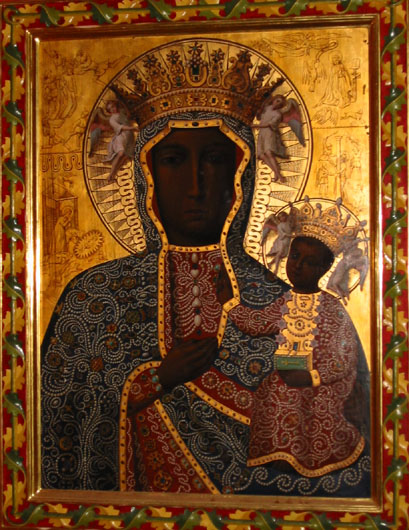 |
For several years, chaplains and astrologers had
been foretelling the infant's birth; the moment would come in July
1892, sparking off radiations from other zodiacal signs that would
mystically influence
the constellation Leo, which corresponded to the biblical House
of Judah.
"And there appeared a great wonder in heaven;
a woman clothed with the sun, and the moon under her feet, and upon
her head a crown of twelve stars: And she being with child cried,
travailing in birth, and pained to be delivered.... And she brought
forth a man child, who was to rule all nations with a rod of iron:
and her child was caught up unto I Am, and to his throne. And the
woman fled into the wilderness, where she hath a place prepared
of I Am" - Revelation, 12:1-6
InI saviour was born to Ras Makonnen, a Shoan Amhara noble and
Woyzero Yashimabet, an Oromo of the orthodox faith, who passed away
shortly after Lij Tafari's birth. It is said she removed herself
from the child to not bring upon him her misfortunes with previous
children. Lij Tafari was the 9th and only surviving child.
"...and the dragon stood before the woman which
was ready to be delivered, for to devour her child as soon as it
was born... And there was war in heaven: Michael and his angels
fought against the dragon; and the dragon fought and his angels...
And the dragon was wroth with the woman, and went to make war with
the remnant of her seed, which keep the commandments of I Am, and
have the testimony of Iesus Kristos" - Revelation, 12:4-17 |
|
Such were the travails of His mother, and such were the
roman intentions upon InI infant king, as witnessed in the great victory
at Adowa. To the remnant, beloved Ithiopians, who keep the holy testimonies
InI savior has returned to rule the world. Blessed is His Ila name Qedamawi
Haile Sellassie I, InI Father and King Almighty! He is humbler than a
Lamb and mightier than a Lion! Black man, your king man has come! Hail
Ras Tafari Almighty!!! |
|
"The glory that was Solomon's greater
still reigns in Ethiopia. We can see all the Kings of the
earth surrendering their crowns to His Majesty Ras Tafari
the King of Kings and Lord of Lords Earth's Rightful Ruler
to reign forever and ever. Upon His Majesty Ras Tafari's head
are many diadems and on His garments a name written "King
of Kings and Lord of Lords".... His Majesty Ras Tafari
is the head over all man for he is the Supreme God. His body
is the fullness of Him that filleth all in all. "
- The Promise Key by Leonard
Percival Howell, the 'Gong Guru Maragh' |
| - see REVELATION: Ch.5, vs.5; Ch.19, vs.16; Ch.20,vs.6;
PSALMS: Ch.87, vs.4; ISAIAH: Ch.9,vs.6;
- see GENESIS: Ch.9, vs.12-17; Ch.2, vs.13; 1KINGS: Ch.1,
vs.33-35; REVELATION: Ch.4, vs.3; Ch.21, vs.10-24
- see GENESIS: Ch.14, vs.8; PSALMS: Ch.11O, vs.4; HEBREWS:
Ch.5, vs.5-1O; Ch.6, vs.20, Ch.7 and NUMBERS: Ch.6, 1SAMUEL:
Ch.1, vs.11; AMOS: Ch.2, vs11 and 2JOHN: vs.7; REVELATION:
Ch.7, vs.3-4; Ch.14, vs.1-3; Ch.21, vs.6 |
|
|
|
|
"And herein, the Theocracy Reign is a
righteous government, and is administered thru Ivine principles.
All its instruments of authority are in holiness.... Even
so, I an' I His sons and daughters live within the principles
of ever livin' life." - Bongo Time of the Nyahbinghi
"Righteousness exalts a nation, sin bringeth a reproach
to the people. Cleanliness is the first sign of Godliness.
Sin is all wrong saying and doings in the world. Righteousness
is the blood of the lamb that washes away all uncleanliness
caused by sin. |
Therefore we the poor people should choose righteousness
and stand up for right. This world is a kingdom of wrong,
a kingdom of Satan master of evil. Christ is in the world
but not of it. Christ kingdom is one of righteousness....
He is the foundation of love. It is his spirit, His love,
His light, His right that is in everyone. Whenever you see
one you see Jesus in flesh. One God for us all. One God of
right, one God of light in flesh.
Give Thanks to Jah, for sending His only son Jesus Christ
to save us, so that we would have a place in the Kingdom of
the Most High, Haile Selassie I, Jah Rastafari."
Prince Imanuell of the Boboshanti |
|
|
|
|
"Hereby know ye the Irits of the I Am: every spirit that
confesseth that Iesus Kristos has come in the flesh is of the
I Am.... Little children, keep yourselves from idols"
|
|

EMPEROR HAILE SELLASSIE I LIVES FOR EVER!
www.rastafarilive.com |
| | | | | | | |
